Healthcare Strategies: Patient Care, Lawsuits, and Governance
VerifiedAdded on 2022/11/03
|6
|1180
|237
Report
AI Summary
This report, focused on healthcare strategies, delves into the critical responsibilities of a healthcare administrator. It examines protocol standardization, emphasizing the importance of checklists and standardized procedures to enhance patient care and minimize complications. The report explores the legal landscape, addressing patient care and lawsuits, including the roles of hospitals and physicians in cases of medical negligence. It also highlights the Patient Safety and Quality Improvement Act and its implications. Furthermore, the report discusses the roles of plaintiffs and the governing board in medical malpractice cases, emphasizing the board's responsibility for quality patient care and the appointment of risk managers. The conclusion stresses the administrator's duty to oversee patient care and develop strategies to reduce adverse patient outcomes. The report references several key sources to support its findings.
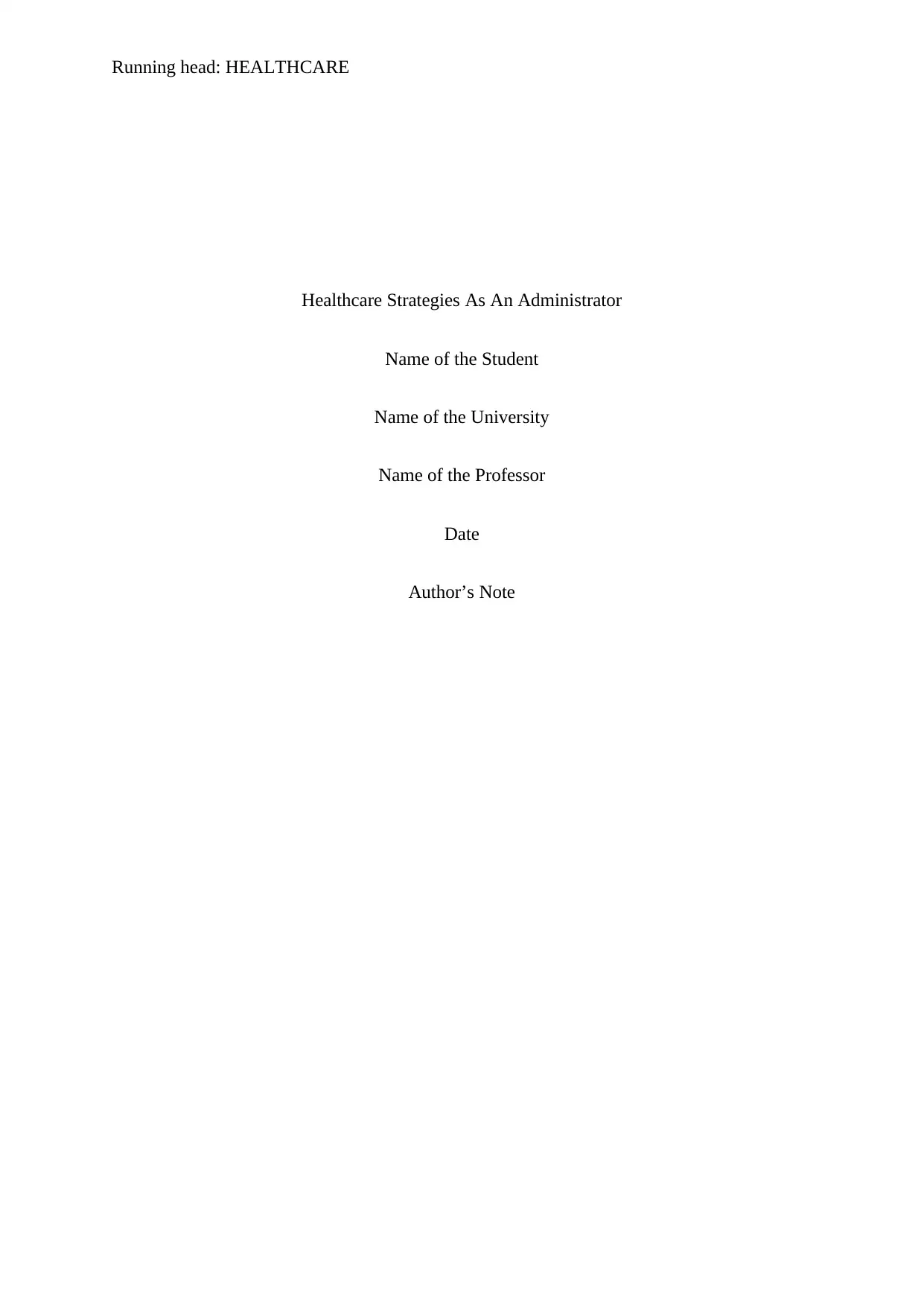
Running head: HEALTHCARE
Healthcare Strategies As An Administrator
Name of the Student
Name of the University
Name of the Professor
Date
Author’s Note
Healthcare Strategies As An Administrator
Name of the Student
Name of the University
Name of the Professor
Date
Author’s Note
Paraphrase This Document
Need a fresh take? Get an instant paraphrase of this document with our AI Paraphraser
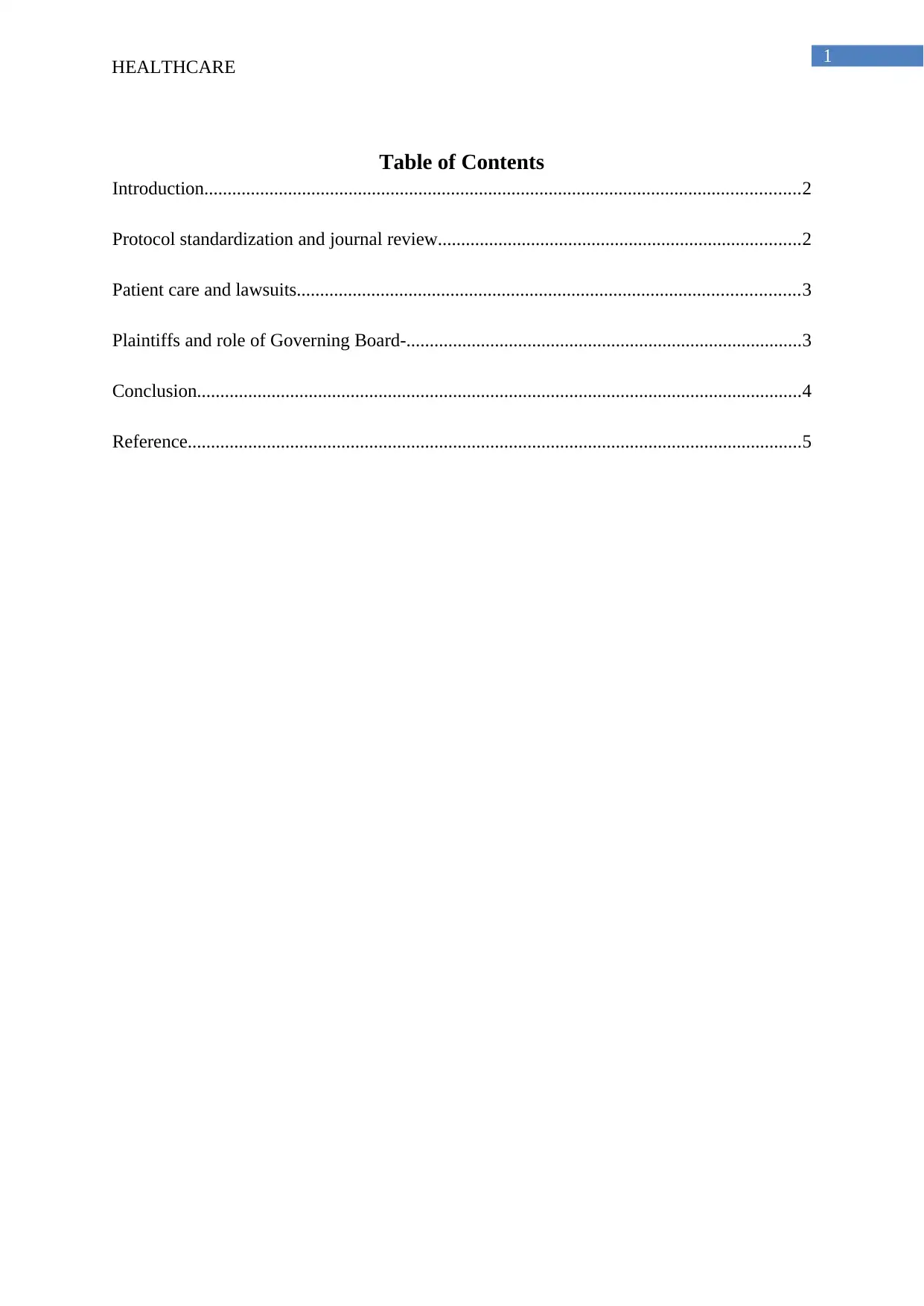
1
HEALTHCARE
Table of Contents
Introduction................................................................................................................................2
Protocol standardization and journal review..............................................................................2
Patient care and lawsuits............................................................................................................3
Plaintiffs and role of Governing Board-.....................................................................................3
Conclusion..................................................................................................................................4
Reference....................................................................................................................................5
HEALTHCARE
Table of Contents
Introduction................................................................................................................................2
Protocol standardization and journal review..............................................................................2
Patient care and lawsuits............................................................................................................3
Plaintiffs and role of Governing Board-.....................................................................................3
Conclusion..................................................................................................................................4
Reference....................................................................................................................................5
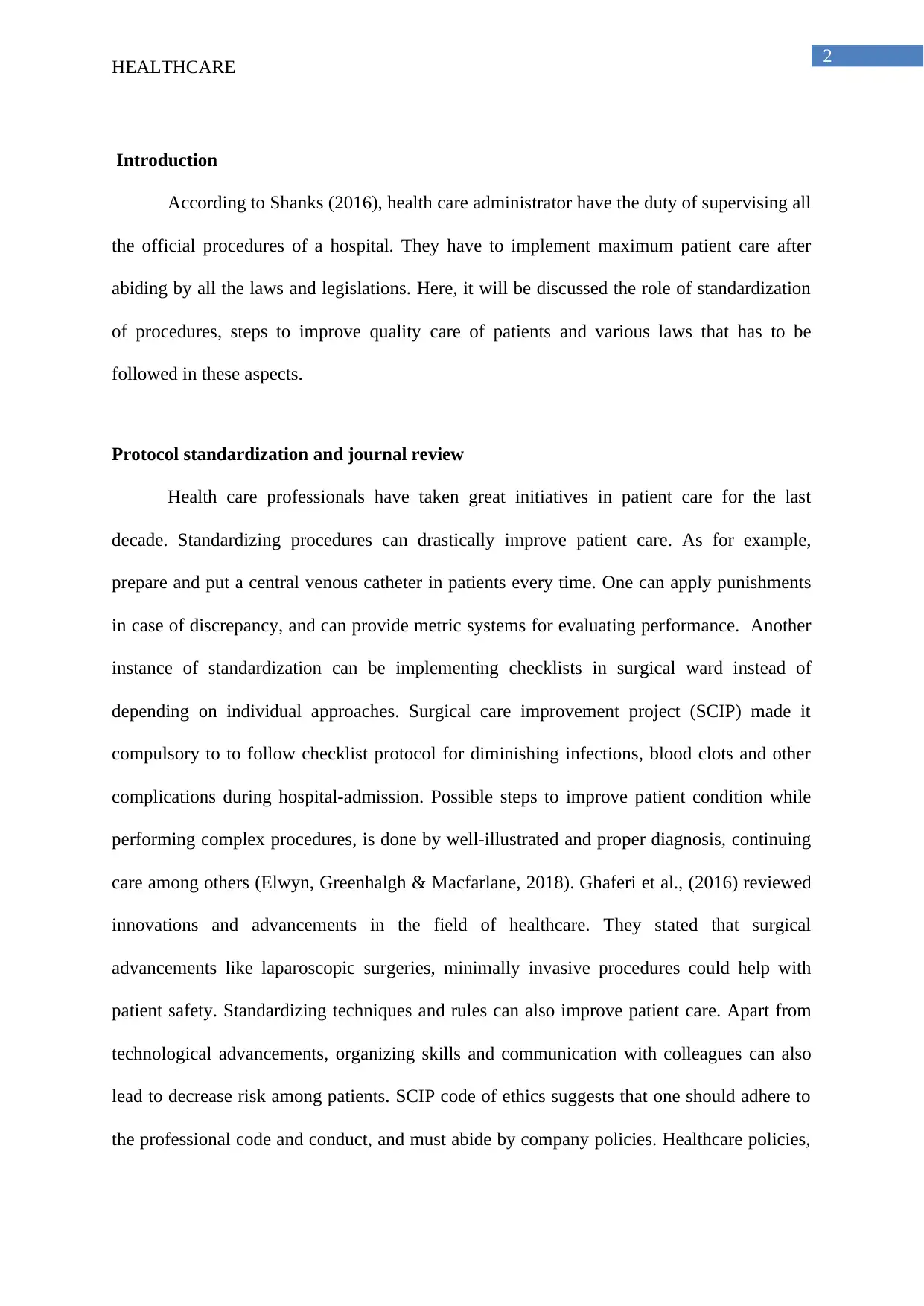
2
HEALTHCARE
Introduction
According to Shanks (2016), health care administrator have the duty of supervising all
the official procedures of a hospital. They have to implement maximum patient care after
abiding by all the laws and legislations. Here, it will be discussed the role of standardization
of procedures, steps to improve quality care of patients and various laws that has to be
followed in these aspects.
Protocol standardization and journal review
Health care professionals have taken great initiatives in patient care for the last
decade. Standardizing procedures can drastically improve patient care. As for example,
prepare and put a central venous catheter in patients every time. One can apply punishments
in case of discrepancy, and can provide metric systems for evaluating performance. Another
instance of standardization can be implementing checklists in surgical ward instead of
depending on individual approaches. Surgical care improvement project (SCIP) made it
compulsory to to follow checklist protocol for diminishing infections, blood clots and other
complications during hospital-admission. Possible steps to improve patient condition while
performing complex procedures, is done by well-illustrated and proper diagnosis, continuing
care among others (Elwyn, Greenhalgh & Macfarlane, 2018). Ghaferi et al., (2016) reviewed
innovations and advancements in the field of healthcare. They stated that surgical
advancements like laparoscopic surgeries, minimally invasive procedures could help with
patient safety. Standardizing techniques and rules can also improve patient care. Apart from
technological advancements, organizing skills and communication with colleagues can also
lead to decrease risk among patients. SCIP code of ethics suggests that one should adhere to
the professional code and conduct, and must abide by company policies. Healthcare policies,
HEALTHCARE
Introduction
According to Shanks (2016), health care administrator have the duty of supervising all
the official procedures of a hospital. They have to implement maximum patient care after
abiding by all the laws and legislations. Here, it will be discussed the role of standardization
of procedures, steps to improve quality care of patients and various laws that has to be
followed in these aspects.
Protocol standardization and journal review
Health care professionals have taken great initiatives in patient care for the last
decade. Standardizing procedures can drastically improve patient care. As for example,
prepare and put a central venous catheter in patients every time. One can apply punishments
in case of discrepancy, and can provide metric systems for evaluating performance. Another
instance of standardization can be implementing checklists in surgical ward instead of
depending on individual approaches. Surgical care improvement project (SCIP) made it
compulsory to to follow checklist protocol for diminishing infections, blood clots and other
complications during hospital-admission. Possible steps to improve patient condition while
performing complex procedures, is done by well-illustrated and proper diagnosis, continuing
care among others (Elwyn, Greenhalgh & Macfarlane, 2018). Ghaferi et al., (2016) reviewed
innovations and advancements in the field of healthcare. They stated that surgical
advancements like laparoscopic surgeries, minimally invasive procedures could help with
patient safety. Standardizing techniques and rules can also improve patient care. Apart from
technological advancements, organizing skills and communication with colleagues can also
lead to decrease risk among patients. SCIP code of ethics suggests that one should adhere to
the professional code and conduct, and must abide by company policies. Healthcare policies,
⊘ This is a preview!⊘
Do you want full access?
Subscribe today to unlock all pages.

Trusted by 1+ million students worldwide
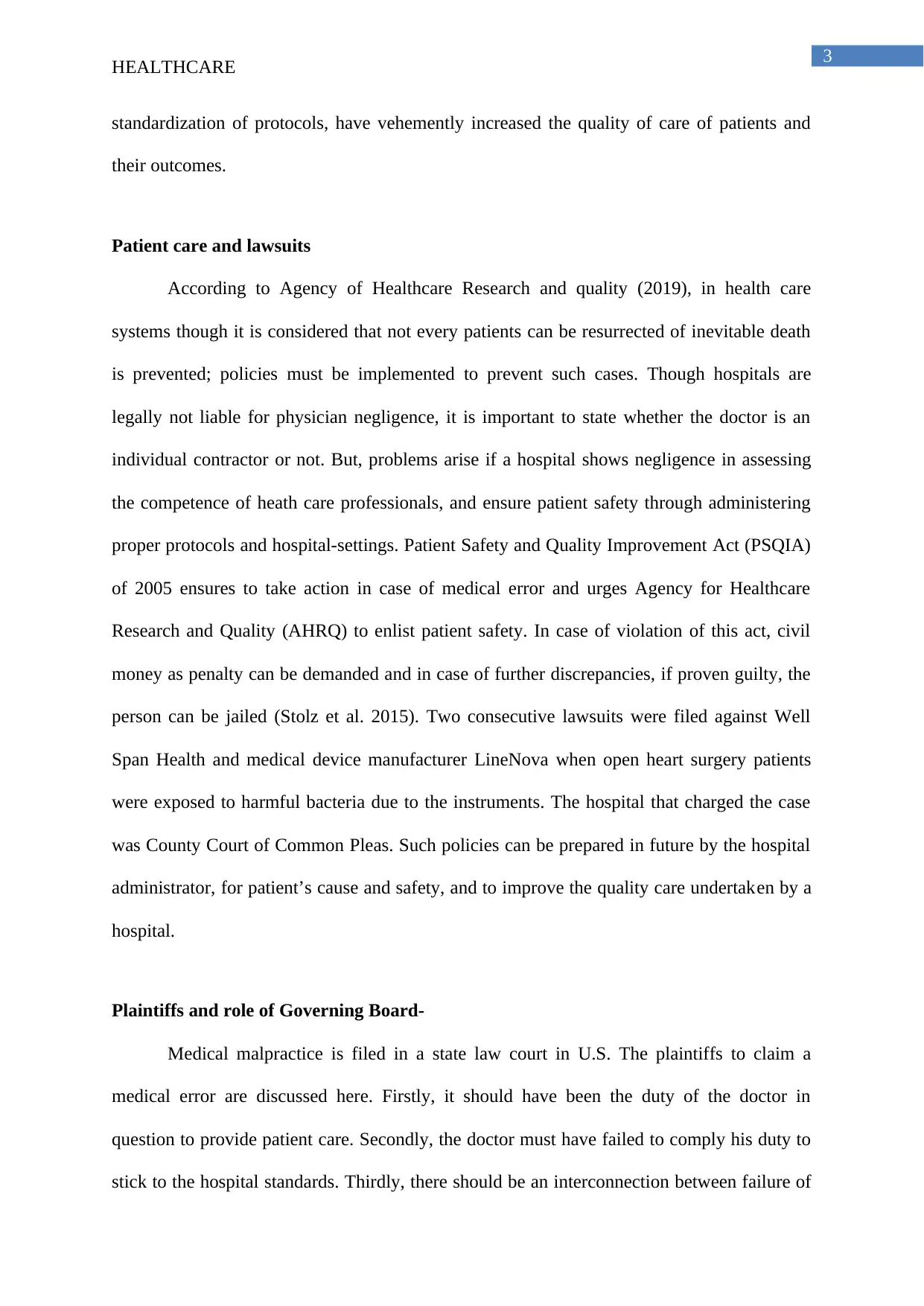
3
HEALTHCARE
standardization of protocols, have vehemently increased the quality of care of patients and
their outcomes.
Patient care and lawsuits
According to Agency of Healthcare Research and quality (2019), in health care
systems though it is considered that not every patients can be resurrected of inevitable death
is prevented; policies must be implemented to prevent such cases. Though hospitals are
legally not liable for physician negligence, it is important to state whether the doctor is an
individual contractor or not. But, problems arise if a hospital shows negligence in assessing
the competence of heath care professionals, and ensure patient safety through administering
proper protocols and hospital-settings. Patient Safety and Quality Improvement Act (PSQIA)
of 2005 ensures to take action in case of medical error and urges Agency for Healthcare
Research and Quality (AHRQ) to enlist patient safety. In case of violation of this act, civil
money as penalty can be demanded and in case of further discrepancies, if proven guilty, the
person can be jailed (Stolz et al. 2015). Two consecutive lawsuits were filed against Well
Span Health and medical device manufacturer LineNova when open heart surgery patients
were exposed to harmful bacteria due to the instruments. The hospital that charged the case
was County Court of Common Pleas. Such policies can be prepared in future by the hospital
administrator, for patient’s cause and safety, and to improve the quality care undertaken by a
hospital.
Plaintiffs and role of Governing Board-
Medical malpractice is filed in a state law court in U.S. The plaintiffs to claim a
medical error are discussed here. Firstly, it should have been the duty of the doctor in
question to provide patient care. Secondly, the doctor must have failed to comply his duty to
stick to the hospital standards. Thirdly, there should be an interconnection between failure of
HEALTHCARE
standardization of protocols, have vehemently increased the quality of care of patients and
their outcomes.
Patient care and lawsuits
According to Agency of Healthcare Research and quality (2019), in health care
systems though it is considered that not every patients can be resurrected of inevitable death
is prevented; policies must be implemented to prevent such cases. Though hospitals are
legally not liable for physician negligence, it is important to state whether the doctor is an
individual contractor or not. But, problems arise if a hospital shows negligence in assessing
the competence of heath care professionals, and ensure patient safety through administering
proper protocols and hospital-settings. Patient Safety and Quality Improvement Act (PSQIA)
of 2005 ensures to take action in case of medical error and urges Agency for Healthcare
Research and Quality (AHRQ) to enlist patient safety. In case of violation of this act, civil
money as penalty can be demanded and in case of further discrepancies, if proven guilty, the
person can be jailed (Stolz et al. 2015). Two consecutive lawsuits were filed against Well
Span Health and medical device manufacturer LineNova when open heart surgery patients
were exposed to harmful bacteria due to the instruments. The hospital that charged the case
was County Court of Common Pleas. Such policies can be prepared in future by the hospital
administrator, for patient’s cause and safety, and to improve the quality care undertaken by a
hospital.
Plaintiffs and role of Governing Board-
Medical malpractice is filed in a state law court in U.S. The plaintiffs to claim a
medical error are discussed here. Firstly, it should have been the duty of the doctor in
question to provide patient care. Secondly, the doctor must have failed to comply his duty to
stick to the hospital standards. Thirdly, there should be an interconnection between failure of
Paraphrase This Document
Need a fresh take? Get an instant paraphrase of this document with our AI Paraphraser
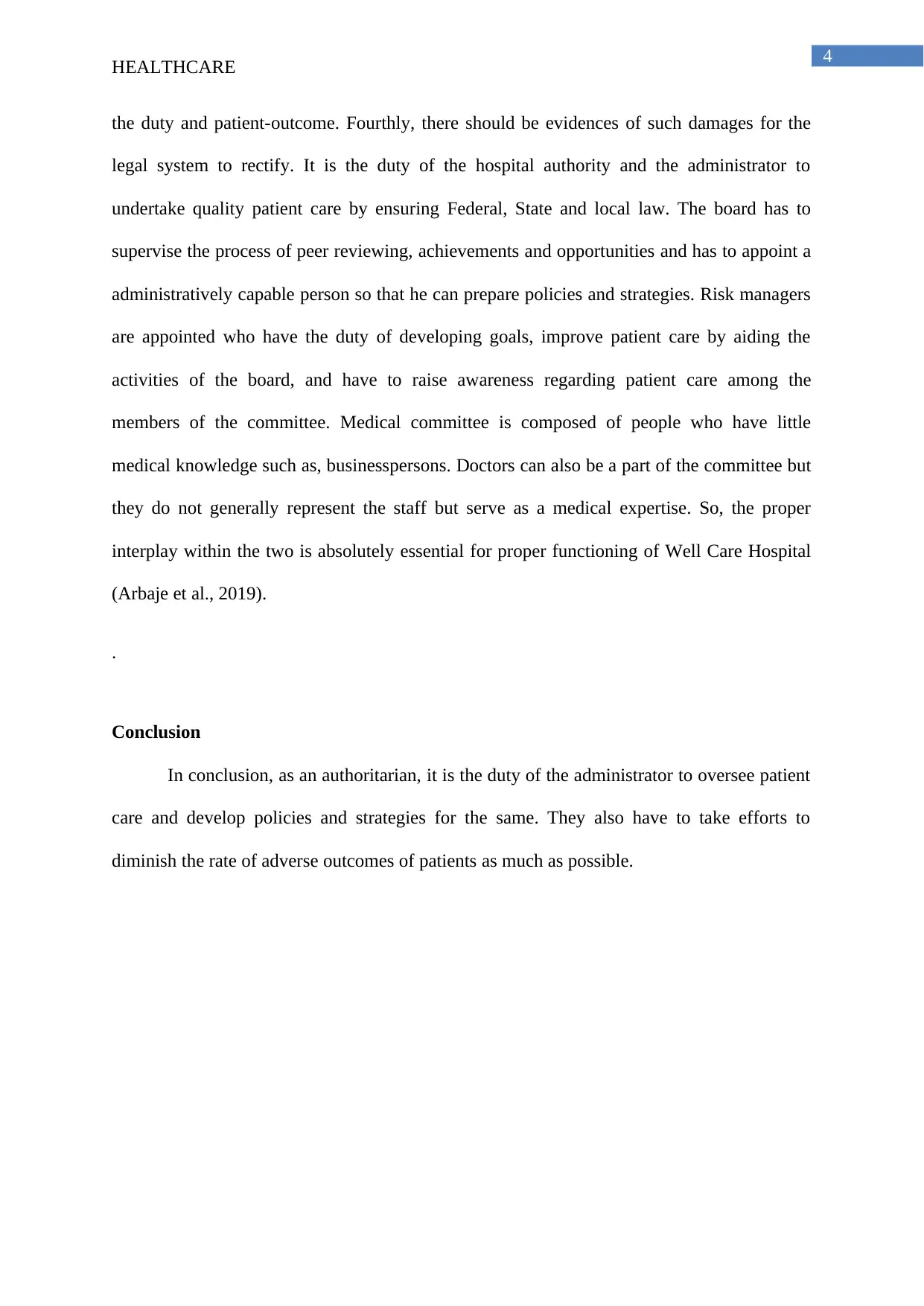
4
HEALTHCARE
the duty and patient-outcome. Fourthly, there should be evidences of such damages for the
legal system to rectify. It is the duty of the hospital authority and the administrator to
undertake quality patient care by ensuring Federal, State and local law. The board has to
supervise the process of peer reviewing, achievements and opportunities and has to appoint a
administratively capable person so that he can prepare policies and strategies. Risk managers
are appointed who have the duty of developing goals, improve patient care by aiding the
activities of the board, and have to raise awareness regarding patient care among the
members of the committee. Medical committee is composed of people who have little
medical knowledge such as, businesspersons. Doctors can also be a part of the committee but
they do not generally represent the staff but serve as a medical expertise. So, the proper
interplay within the two is absolutely essential for proper functioning of Well Care Hospital
(Arbaje et al., 2019).
.
Conclusion
In conclusion, as an authoritarian, it is the duty of the administrator to oversee patient
care and develop policies and strategies for the same. They also have to take efforts to
diminish the rate of adverse outcomes of patients as much as possible.
HEALTHCARE
the duty and patient-outcome. Fourthly, there should be evidences of such damages for the
legal system to rectify. It is the duty of the hospital authority and the administrator to
undertake quality patient care by ensuring Federal, State and local law. The board has to
supervise the process of peer reviewing, achievements and opportunities and has to appoint a
administratively capable person so that he can prepare policies and strategies. Risk managers
are appointed who have the duty of developing goals, improve patient care by aiding the
activities of the board, and have to raise awareness regarding patient care among the
members of the committee. Medical committee is composed of people who have little
medical knowledge such as, businesspersons. Doctors can also be a part of the committee but
they do not generally represent the staff but serve as a medical expertise. So, the proper
interplay within the two is absolutely essential for proper functioning of Well Care Hospital
(Arbaje et al., 2019).
.
Conclusion
In conclusion, as an authoritarian, it is the duty of the administrator to oversee patient
care and develop policies and strategies for the same. They also have to take efforts to
diminish the rate of adverse outcomes of patients as much as possible.
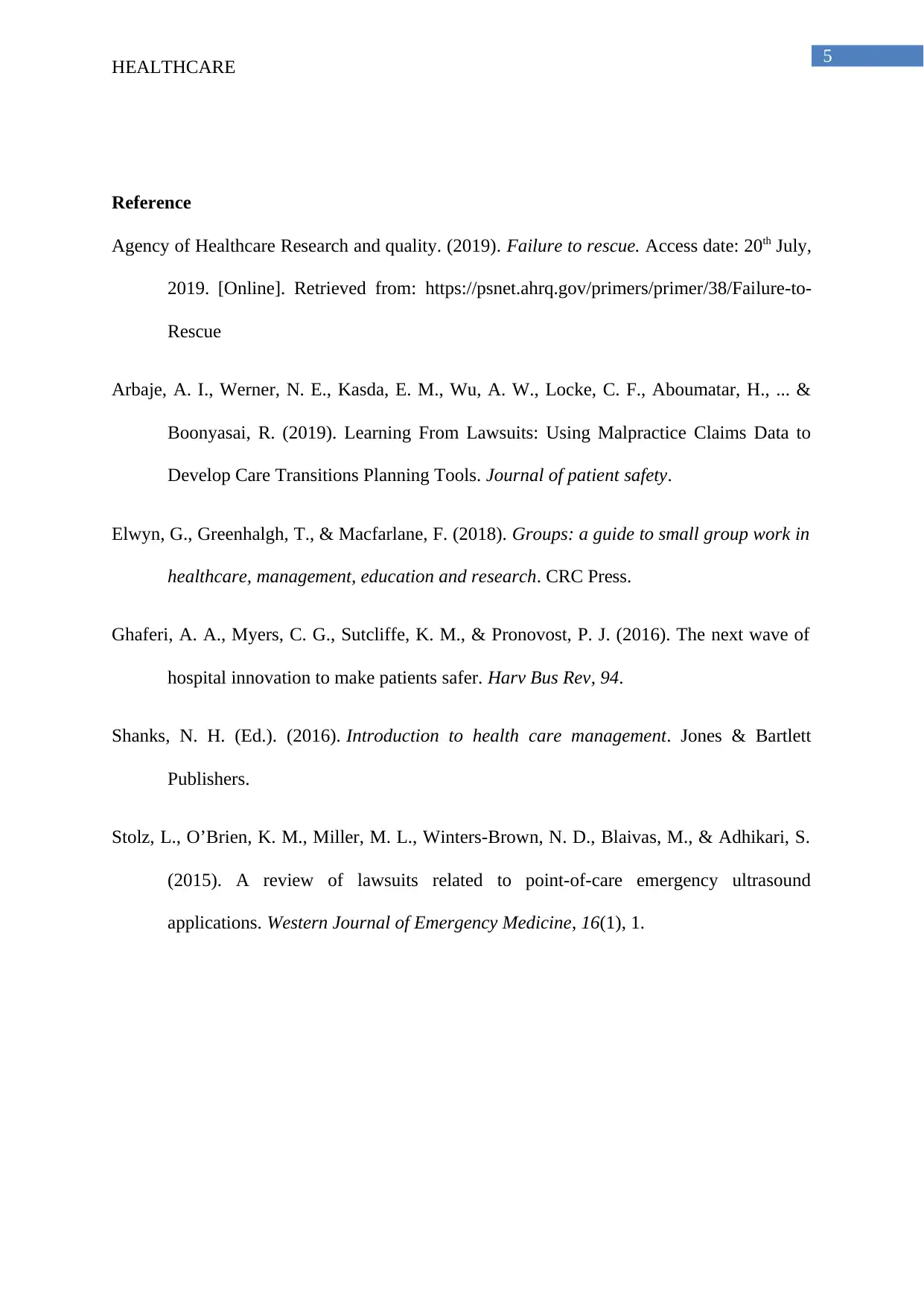
5
HEALTHCARE
Reference
Agency of Healthcare Research and quality. (2019). Failure to rescue. Access date: 20th July,
2019. [Online]. Retrieved from: https://psnet.ahrq.gov/primers/primer/38/Failure-to-
Rescue
Arbaje, A. I., Werner, N. E., Kasda, E. M., Wu, A. W., Locke, C. F., Aboumatar, H., ... &
Boonyasai, R. (2019). Learning From Lawsuits: Using Malpractice Claims Data to
Develop Care Transitions Planning Tools. Journal of patient safety.
Elwyn, G., Greenhalgh, T., & Macfarlane, F. (2018). Groups: a guide to small group work in
healthcare, management, education and research. CRC Press.
Ghaferi, A. A., Myers, C. G., Sutcliffe, K. M., & Pronovost, P. J. (2016). The next wave of
hospital innovation to make patients safer. Harv Bus Rev, 94.
Shanks, N. H. (Ed.). (2016). Introduction to health care management. Jones & Bartlett
Publishers.
Stolz, L., O’Brien, K. M., Miller, M. L., Winters-Brown, N. D., Blaivas, M., & Adhikari, S.
(2015). A review of lawsuits related to point-of-care emergency ultrasound
applications. Western Journal of Emergency Medicine, 16(1), 1.
HEALTHCARE
Reference
Agency of Healthcare Research and quality. (2019). Failure to rescue. Access date: 20th July,
2019. [Online]. Retrieved from: https://psnet.ahrq.gov/primers/primer/38/Failure-to-
Rescue
Arbaje, A. I., Werner, N. E., Kasda, E. M., Wu, A. W., Locke, C. F., Aboumatar, H., ... &
Boonyasai, R. (2019). Learning From Lawsuits: Using Malpractice Claims Data to
Develop Care Transitions Planning Tools. Journal of patient safety.
Elwyn, G., Greenhalgh, T., & Macfarlane, F. (2018). Groups: a guide to small group work in
healthcare, management, education and research. CRC Press.
Ghaferi, A. A., Myers, C. G., Sutcliffe, K. M., & Pronovost, P. J. (2016). The next wave of
hospital innovation to make patients safer. Harv Bus Rev, 94.
Shanks, N. H. (Ed.). (2016). Introduction to health care management. Jones & Bartlett
Publishers.
Stolz, L., O’Brien, K. M., Miller, M. L., Winters-Brown, N. D., Blaivas, M., & Adhikari, S.
(2015). A review of lawsuits related to point-of-care emergency ultrasound
applications. Western Journal of Emergency Medicine, 16(1), 1.
⊘ This is a preview!⊘
Do you want full access?
Subscribe today to unlock all pages.

Trusted by 1+ million students worldwide
1 out of 6
Related Documents
Your All-in-One AI-Powered Toolkit for Academic Success.
+13062052269
info@desklib.com
Available 24*7 on WhatsApp / Email
![[object Object]](/_next/static/media/star-bottom.7253800d.svg)
Unlock your academic potential
Copyright © 2020–2025 A2Z Services. All Rights Reserved. Developed and managed by ZUCOL.





